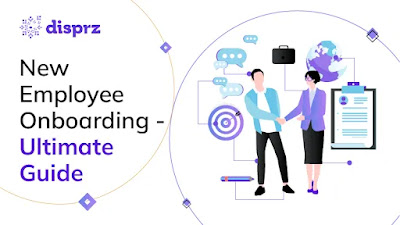Onboarding and Integrating New Hires in a Hybrid Work Model
With the rise of hybrid work environments, organisations increasingly face another growing challenge: how to onboard and successfully integrate new hires who may never set foot in the office. Onboarding, if taken in the more traditional sense, usually involves in-person introductions, company tours, and face-to-face training sessions-all so important in linking employees with a company's culture and values.
But with many employees now working at home or in hybrid settings, organisations need to reimagine the onboarding experience so new employees feel welcome, enabled, and connected wherever they work.
This article covers how to make the robust onboarding process engaging and effective for the recruits towards the organisations through a hybrid work model. We have discussed some key strategies for virtual buddy systems, interactive onboarding programs, and hybrid mentoring that help keep new hires connected with the organisation and their colleagues.
The Hybrid Onboarding Challenge
Onboarding is one of the most critical phases in an employee's journey. It's when they first encounter the company culture, establish relationships, and learn the systems and expectations that will guide their work. However, hybrid work presents unique challenges:
Limited Face-to-Face Interaction: Without the in-person elements of traditional onboarding, new hires might struggle to connect with their coworkers or understand the company’s informal culture.
Increased Isolation: Remote work can leave employees feeling disconnected, which may impact engagement and productivity.
Technology and Learning Curve: New hires may face challenges navigating remote work tools or understanding how to effectively communicate in a digital environment.
Cultural Disconnect: It's harder for new employees to absorb company culture when they’re not physically present to witness team dynamics and office interactions.
While these challenges are real, they’re not insurmountable. By adopting strategies tailored to the hybrid work model, organisations can turn onboarding into an engaging, inclusive, and effective experience.
Strategies for Successful Hybrid Onboarding
1. Virtual Buddy Systems
One of the most successful strategies for hybrid onboarding is implementing a virtual buddy system. In this setup, a more experienced employee (the "buddy") helps the new hire navigate the early days and weeks in the company. The buddy answers questions, provides insights into company culture, and offers a support system for the new employee—serving as both a resource and a friend.
Research has shown that employees with a designated buddy feel more comfortable and supported in their roles, leading to higher levels of engagement and quicker adaptation to the workplace (Bauer, 2010). For hybrid teams, the buddy system can be fully virtual, utilising video calls, instant messaging, and collaborative tools like Slack or Microsoft Teams to maintain regular check-ins. The buddy helps the new hire feel connected to the team, even if they’re working remotely.
2. Interactive Onboarding Programs
Interactive and engaging onboarding programs can replace the old-school approach of static, presentation-heavy onboarding sessions. In a hybrid work environment, an interactive program allows new hires to learn about the company in a dynamic way. This might include gamified elements, digital scavenger hunts, or team challenges that encourage employees to explore the company’s values, history, and goals.
Onboarding platforms such as WorkBright or BambooHR can provide self-paced training modules, while HR teams can schedule live webinars and Q&A sessions with senior leadership to give new hires the chance to interact with top executives. These interactive formats not only help new employees gain the necessary knowledge but also encourage them to engage with the material actively, making learning more fun and memorable (Fowler, 2019).
3. Hybrid Mentoring Programs
Mentoring can be a powerful tool in any work setting, but it’s especially vital for hybrid teams, where new hires might feel isolated or disconnected. Hybrid mentoring combines the best of both in-person and remote interactions by pairing new hires with experienced employees who guide them through both work tasks and cultural integration.
A successful hybrid mentoring program balances digital communication with occasional in-person meetups (when possible). Regular video calls, email exchanges, and virtual coffee chats allow for flexibility while still maintaining the essence of mentoring relationships. Mentors can help new hires understand the unspoken norms and expectations of the company, offer advice, and serve as a sounding board for ideas.
Onboarding new hires into hybrid work is going to need some creativity, flexibility, and intentionality. The implementation of strategies such as a virtual buddy system, interactive onboarding programs, and hybrid mentoring helps organisations make their new employees feel connected from the very beginning, supported, and integrated. Communication should be transparent, social opportunities frequent, company culture emphasised to make the environment a place for new hires.
When well executed, onboarding is much more than a training mechanism; it's the bedrock upon which strong and lasting relations, better engagement, and fit of employees are established within an organisation. Thus, with continuing evolution in hybrid work, such organisations that invest in effective onboarding will see the benefits of a more cohesive, committed, and productive workforce.
References
Bauer, T. N. (2010). Onboarding new employees: Maximizing success. SHRM Foundation’s Effective Practice Guidelines Series.
Fowler, S. (2019). Virtual onboarding: Best practices for engaging employees remotely. Journal of Workplace Learning, 31(5), 399-412.
Kram, K. E. (1985). Mentoring at work: Developmental relationships in organizational life. University Press of America.
Wilson, J. M., O'Leary, M. B., Metiu, A., & Jett, Q. R. (2008). Perceived proximity in virtual work: Explaining the paradox of far-but-close. Organization Studies, 29(7), 979–1002.





With hybrid work becoming more prevalent, what other strategies do you think could help bridge the gap between remote and in-office experiences for new hires? Have you encountered or implemented any innovative onboarding practices that make hybrid onboarding more effective?
ReplyDeleteWill these challenges totally overcome?
ReplyDeleteYes, So many I think
DeleteHow can companies ensure that new hires in a hybrid work setting feel fully integrated into the company culture?
ReplyDeleteTo ensure new hires feel integrated into the company culture in a hybrid setting, companies can start with a well structured onboarding process that includes both virtual and in-person components
DeleteThe emphasis on fostering connections through virtual buddy systems and hybrid mentoring is a strong approach, especially as it recognizes the unique challenges of blending remote and in-person dynamics. The strategies suggested here not only support the new hire's practical integration but also help in building a sense of belonging and cultural alignment, which are often harder to achieve remotely.
ReplyDeleteExactly! The combination of virtual buddy systems and hybrid mentoring creates a supportive, personal touch that is essential for building connections in a hybrid environment.
DeleteHow can we overcome the communication challenges in Sri Lanka ? (Network issues in remote areas)
ReplyDeleteOvercoming communication challenges in Sri Lanka, particularly network issues in remote areas, requires a blend of technology, infrastructure development, and policy support. Expanding network towers and improving local connectivity through public Wi-Fi hotspots and community communication centers can provide access to more reliable networks.
DeleteThis article is an excellent guide to making onboarding effective in a hybrid work model! I particularly appreciate the focus on the virtual buddy system and hybrid mentoring, which can make a big difference in helping new hires feel supported and connected.
ReplyDeleteWhat methods would you recommend for gathering feedback from new hires on the effectiveness of the hybrid onboarding process?
Onboarding Surveys,Targeted Questions, HR Follow Ups, Anonymous Feedback Platforms,
DeleteOnboarding and integrating new hires in a hybrid work model requires a thoughtful approach to ensure they feel connected and supported from day one. Balancing virtual and in-person interactions helps new team members build relationships, understand company culture, and learn workflows effectively. Providing structured onboarding materials, regular check-ins, and access to mentors can smooth the transition and make remote aspects of the onboarding feel as engaging as in-office experiences. Clear communication and flexibility are key to helping new hires thrive in a hybrid environment..most important and attractive article.
ReplyDeleteMuch appreciated
Delete